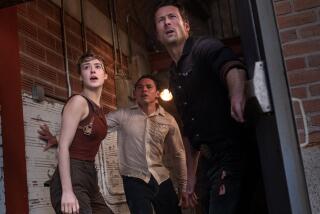Uproar Over Film of Golden Gate Suicides
- Share via
SAN FRANCISCO — For an entire year the cameras rolled, capturing death amid the eerie fog and shifting tides.
One by one, filmmaker Eric Steel documented the final moments of nearly two dozen despondent men and women, and the agonizing, four-second fall after they leaped off the Golden Gate Bridge, drawn by the span’s tragic beauty.
His intent, he says, was to illuminate “the darkest corner of the human mind.” If he watched enough people take their own lives, he thought, he could “spot the outward manifestations of their interior demons.”
Steel says he too once considered suicide. “It’s that Humpty Dumpty moment when it’s all going to fall apart,” he said. “For me and many others, it didn’t come. For the people in this film, it did.”
His documentary, “The Bridge,” which opens at a film festival in San Francisco on Sunday after debuting Thursday in New York City, has already provoked outrage.
“This is like a newspaper carrying a front-page photo of someone blowing his head off; it’s irresponsible, exploitative, voyeuristic, ghastly and immoral,” said Mark Chaffee, president of Suicide Prevention Advocacy Network-California, who has not seen the movie. His 16-year-old son took his life in 1998.
“The phenomena of copycat suicides come from people just reading about this. Now we’re showing it in full color on the big screen? That’s just beautiful.”
The project set off alarms soon after shooting wrapped in December 2004 after 365 consecutive days of filming.
Officials from the Golden Gate National Recreation Area said Steel misrepresented his project when applying for filming permits, telling them he wanted to capture the grandeur of the iconic orange suspension bridge.
Instead, they complain, he made what one San Francisco supervisor dismissed in media coverage as a “snuff film.”
Others say publicity over the movie prompted bridge officials to fund a $2-million study of building a pedestrian suicide barrier -- a move they had long resisted.
The 93-minute documentary draws from 10,000 hours of footage, including interviews with relatives of jumpers, and with one man who survived the 25-story plunge into the frigid water.
The film shows vivid footage of suicides, including a body pulled from the bay, and interviews with families struggling with the wreckage the jumpers left behind. Interspersed are time-lapse views of the bridge -- coursing with traffic -- through gloomy, almost ever-present fog.
Steel tells the tragic stories of several victims -- such as a 34-year-old Bay Area man depressed by his mother’s death.
Wearing a black leather jacket and sunglasses -- his long, black hair flying in the wind -- he is seen casing the pedestrian walkway, which he did for 90 minutes. Then he jumps atop the 4-foot railing, slowly turns and almost casually falls backward -- as though taking a summer day’s plunge into a backyard pool.
Also interviewed is Kevin Hines, who, in 2000, survived his jump. Now 25, he speaks freely about his ordeal with manic-depression in the hope that a suicide barrier will be built.
“This film shows what a suicidal person feels like, what their family feels like,” said Hines, who has seen the movie. “It shows this happens all the time.”
While Steel looks for a domestic distributor for his documentary, film festival officials here worry about audience reaction.
“The images are not immediately digestible, and people might initially be confused and fly off the handle. They may react angrily,” said Graham Leggat, executive director of the San Francisco Film Society, the festival’s sponsor. He plans to moderate a question-and-answer session after the showings.
Since the Golden Gate Bridge opened May 28, 1937, an estimated 1,300 people have leaped to their deaths from the span. Officials estimate that at least 24 people commit suicide there every year.
In a phone interview this week from his Manhattan office, Steel, a film producer and book editor, said he became interested in the bridge in 2003 after he read a story about its fatal attraction for the depressed.
The 42-year-old New York native said he has experienced his own bouts of depression. He lost a brother and a sister -- one to cancer, the other to an accident with a drunk driver.
Steel wanted to know what made people hurl themselves into the bay. “One thing that stuck with me is that someone had to walk from the parking lot to one spot on the bridge before taking that jump,” he said. “That walk must involve the most unimaginable mental anguish.”
He arrived in San Francisco in November 2003. But when he applied for permits, he wrote only that he sought to capture “the powerful, spectacular intersection of monument and nature that takes place every day at the Golden Gate Bridge.”
Steel said he obscured the movie’s purpose to avoid his greatest fear: “I worried word would get out, that someone would jump just to be immortalized on film. Despite criticism I did something unethical, I feel I did the right thing.”
From half a mile away, Steel began filming the bridge on New Year’s Day in 2004. A crew of 12 took shifts from dawn to dusk. With one camera, they recorded the span and water. With a second one, they used a telephoto lens to scan for pedestrians.
The crew quickly learned there was no common suicide profile. “We saw lots of people crying, walking alone with hoods over their heads, their shoulders hunched,” Steel said. “But none of those people jumped.”
Instead, it was the woman with the nervous twitch. And a man who laughed on his cellphone until he blessed himself and pushed off the railing.
Steel established guidelines on when to intervene, instructing the crew to call emergency officials if a pedestrian set down a bag or briefcase, removed shoes or wallet, or climbed onto the rail. They intervened five times to stop jumpers, he said.
“It’s very hard to watch anyone die,” he said. “No one on the crew went unscathed.”
The hardest moments came not on the bridge, but later.
As he recorded the suicides, Steel sought details of the dead. He then crossed the country to interview friends and relatives.
In the film, Wally Manikow, a tax collector from Virginia, ruefully relates a conversation with his son, Philip. “He asked me, ‘Is suicide a sin?’ ” Manikow says as he sits on his living room couch absent-mindedly petting his dog. “I told him, ‘No, that’s something man made up. God is not going to hold it against you.’ ”
With his wife, Mary, beside him, the father pauses, then continues: “He thanked me for telling him the truth.”
Steel did not inform family members that he had filmed their loved one’s suicides. Later, he acknowledged, “individual people called and were upset I didn’t tell them.”
Mary Manikow said Steel has not allowed her to see the movie. She saw footage of their interview Thursday on ABC’s “Good Morning America” where Steel promoted his movie.
“I felt very stripped and naked and exposed when I saw that,” she said. “I’m disappointed that we couldn’t see the portrayal of this personal moment in our lives before the rest of the nation. I guess I feel used.”
Park officials also feel duped. “He was not up front with us,” said Rudy Evenson of the Golden Gate National Recreation Area. Officials deny that Steel’s project influenced the decision to study a suicide barrier. “Does anybody think this movie truly addresses mental health problems?” said Mike Martini, a member of the bridge board of directors who says he will not see the film. “It’s like saying you understand the Civil War after watching ‘Gone With the Wind.’ ”
Steel defends his use of the bridge as a focal point to raise awareness about suicide.
“People take their lives in other places than this bridge,” he said. “They do it privately in locked rooms or barns or motel bathrooms or in college dormitories in the dark. They also do it publicly -- along the metro line in Chicago and from small bridges coast to coast.
“The Golden Gate Bridge is everywhere.”
More to Read
Only good movies
Get the Indie Focus newsletter, Mark Olsen's weekly guide to the world of cinema.
You may occasionally receive promotional content from the Los Angeles Times.











